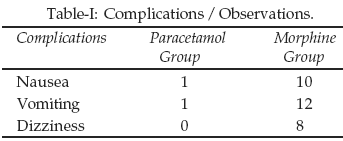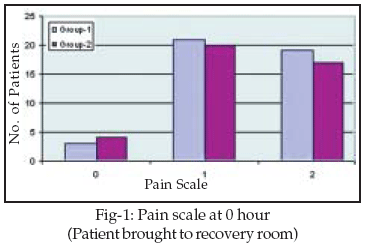|
|
||||
|
Published by : PROFESSIONAL MEDICAL PUBLICATIONS |
||||
|
ISSN 1681-715X |
||||
|
||||
|
- |
||||
|
ORIGINAL ARTICLE |
||||
|
- |
||||
|
Volume 23 |
October - December 2007 (Part-II) |
Number 6 |
||
|
|
||||
|
|
||||
|
|
||||
|
Published by : PROFESSIONAL MEDICAL PUBLICATIONS |
||||
|
ISSN 1681-715X |
||||
|
||||
|
- |
||||
|
ORIGINAL ARTICLE |
||||
|
- |
||||
|
Volume 23 |
October - December 2007 (Part-II) |
Number 6 |
||
|
|
||||
|
|
||||
Intravenous Paracetamol is as effective as Morphine in
Knee Arthroscopic day surgery procedures
Zaka Ullah Khan1, Javaid Iqbal2, Hosny Saleh3, Abeer Mohamed El Deek4
ABSTRACT
Objectives: To conduct a prospective randomized study comparing the analgesic effect of Intravenous Paracetamol with Intravenous Morphine in postoperative pain control of patients undergoing knee arthroscopic surgery as day cases.
Methodology: Eighty four patients were randomised into two groups on the basis of the last digit of their medical number. Odd numbers were given Paracetamol (Group-I) and even Morphine (Group-II). All patients underwent Examination under Anaesthesia (E.U.A) and knee arthroscopy ± a partial menisectomy as day cases and had to stay of a minimum of 4 hours post surgery. A standardize General Anaesthesia was given to both groups. An intra-articular injection of 20mls of 0.5% Marcaine was given to all patients. Postoperative pain was assessed up to 4 hours using the Verbal Rating Scale (V.R.S.). The adverse effects of the drugs were also observed.
Results: Of 84 patients, 76 were males and 8 females. The age range was from 18 to 69 years, weighing from 55 to 90kg. Paracetamol (Group-I) had 43 patients and there were 41 patients in the Morphine (Group-II) Group. The results according to VRS, from 0 to 4 hours showed no difference in the analgesic effect of the two groups, but much less adverse effect were noted in Group-I.
Conclusion: In our study both intravenous Paracetamol and Intravenous Morphine seems to have the same analgesic effect. However, side effects with Intravenous Paracetamol were much less.
KEY WORDS:
Paracetamol, Morphine, Day surgery, Postoperative analgesia.Pak J Med Sci October - December 2007 (Part-II) Vol. 23 No. 6 851-853
1. Dr. Zaka U.
Khan, FRCS (Tr&Orth)
Consultant Orthopaedic Surgeon,
2. Dr Javaid Iqbal, MRCSI
SpR Orthopaedics,
3. Dr Hosny Saleh, FRCSI
Consultant Orthopaedic Surgeon,
4. Dr Abeer Mohamed El Deek, MD
Consultant Anaesthesiologist,
Department of Trauma & Orthopaedics,
Department of Anaesthesia,
1-5: Armed Forces Hospital, Southern region,
Khamis Mushayt, Saudi Arabia.
Correspondence
Dr. Zaka U. Khan,
Armed Forces Hospital, Southern Region,
Department of Trauma & Orthopaedics,
P.O. Box: 101,
Khamis Mushayt,
Kingdom of Saudi Arabia.
E-mail: zaka@doctors.org.uk
* Received for Publication: August 31, 2007
* Revision Received: September 6, 2007
* Revision Accepted: September 24, 2007
INTRODUCTION
Paracetamol (acetaminophen) is an effective and safe analgesic used worldwide to relieve mild to moderate pain.
1 Intravenous Paracetamol has been available in several European countries, where it is mostly used in the short-term management of acute postoperative pain.2 Intravenous Paracetamol has only recently been introduced to Saudi Arabia as an alternative to opiods for short term analgesia. Opiods and non-steroidal anti-inflammatory drugs are the main analgesics used to manage postoperative pain. Morphine remains the ‘Gold Standard‘ against which the Analgesic activity of more recent drugs are measured.3Paracetamol is a viable alternative to non-steroidal ant-inflammatory agents, because of its less adverse effects and is the preferred choice in high risk patients, and could be an alternative to Morphine in certain cases.
4 To our knowledge, no study to this date has compared Intravenous Paracetamol to Intravenous Morphine in short, day surgery procedures, which this study addresses.PATIENTS AND METHODS
In this prospective and double blind study, 84 patients were randomised into two groups on the basis of the last digit of their medical number after getting approval from the research and ethics committee of the institution. Odd numbers were given Paracetamol (Group-I) and even numbers Morphine (Group-II).
All patients who underwent diagnostic knee arthroscopic procedures irrespective of the cause and those with minimal therapeutic procedures (partial menisectomy, removal of loose body and arthroscopic washout etc) were included in this study and those with major procedures (Anterior cruciate ligament reconstruction, Meniscus repair etc) were excluded.
A standardize General Anaesthesia was given to both groups, induction was with Diprivan 2.5mg/kg, Fentanyl 1ug/kg and muscle relaxant and maintained with Nitrous Oxide, Oxygen and Sevoflurane. The paracetemol group received 1gm Paracetemol intravenous infusion over 15 minutes whereas the morphine group received 0.1mg/kg Morphine as an intravenous bolus. These were given at the time of the intra-articular injection of 20 mls of 0.5% marcaine in all patients just before the reversal of the general anaesthesia. The minimum stay of the patient was 4 hours post surgery.
Postoperative pain was assessed up to 4 hours using the Verbal Rating Scale (V.R.S.). According to VRS, scale 0 mean pains free and scale 4 means that patient is in agonising pain. The common adverse effects of the drugs (nausea, vomiting and dizziness etc) were also observed.
RESULTS
Of 84 patients, 76 were males and 8 females. The age range was from 18 to 69 years and that of the weight from 18 to 90 kg. Forty three patients were in the Paracetamol (group-1) and 41 in the Morphine (Group-II) Group. The pain level according to VRS and adverse effects of the two groups, from 0 to 4 hours are shown in Table-I and Figures-1 to 5.


DISCUSSION
Pain management after operation is one of the most important challenges which not only provides certain comfort for the patient, but facilitates early mobilization. Post-operative pain is a classic indication for the use of systemic analgesics.
5Opioids are the primary treatment for patients with moderate to severe pain but these drugs are not always easily tolerated and are associated with dose dependent side effects.
6

Intravenous Paracetamol is the water-soluble formulation of paracetamol with negligible side effects. Its efficacy for treating post-operative pain has been investigated in several studies. In assessing the efficacy of Tramadol and Intravenous Paracetamol for pain after thyroidectomy it was found that although pain relief in Tramadol group was better than the other group, more patients in the Tramadol group experienced nausea and vomiting.7 In another study no difference between Intravenous Paracetamol, Pethidine, Tramadol and Diclofenac in terms of pain control after peripheral injuries was found.8

In our study, although pain intensity scores were comparable between the two groups at any time from 0 to 4 hours, more patients in the Morphine group (Group-2) experienced nasea, vomiting and dizziness thus showing similar results to earlier studies.
REFERENCES
1. Schug SA, Sidebotham DA, McGuinnety M. Acetaminophen as an adjunct to morphine by patient- controlled analgesia in the management of acute postoperative pain. Anesth Analg 1998;87:368-72.
2. Farhat F, Savoyen Jayr. Efficacy of proparacetamol in postoperative pain based on two modes of intravenous administration. Cah Anesthesiol 1995;43(4):351-6.
3. Hugo VA, Thys L, Veekman L. Assessing Analgesia in Single and Repeated Administrations of Proparacetamol for Postoperative Pain: Comparison with Morphine After Dental Surgery. Anesth Analg 2004;98:159-65.
4. Hyllested M, Jones S, Pedersen JL. Comparative effect of paracetamol, NSAIDs or their combination in postoperative pain management: A qualitative review. Brit J Anaesthesia 2002;88(2)199-214.
5. Rieck B, Schwemmlek. Systemic pain therapy, evaluation from surgeon point of view. Reg Cancer Treat 1990;3:122-5.
6. Ranucci M, Cazaniga A, Soro G, Isgor G. Post-operative analgesia for early extubation after cardiac surgery: A prospective randomized trial. Minerva Anesthesiol 1999;65(12):859-65.
7. Dejonckheere M, Desjeux L, Deneu S, Ewalenko P. Intravenous Tramadol compared to Proparacetamol for post-operative analgesia following thyroidectomy. Acta Anaesthesiol Belg 2001;52(1):29-33.
8. Hoogewijis J, Diltoer MW, Hubloue I, Spapen HD. A prospective randomized, open-lable, single blind study comparing four analgesics in the treatment of peripheral injury in the emergency department. Eur J Emerg Med 2000;7(2):119-23.
HOME | SEARCH | CURRENT ISSUE | PAST ISSUES
Professional
Medical Publications
Room No. 522, 5th Floor, Panorama Centre
Building No. 2, P.O. Box 8766, Saddar, Karachi - Pakistan.
Phones : 5688791, 5689285 Fax : 5689860
pjms@pjms.com.pk